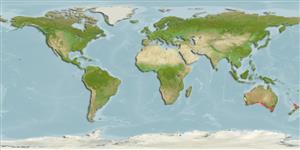Elasmobranchii (sharks and rays) >
Myliobatiformes (Stingrays) >
Myliobatidae (Eagle and manta rays)
Etymology: Myliobatis: Greek, mylo = mill + Greek, + Greek, batis,-idos = a ray (Raja sp.) (Ref. 45335).
More on author: Macleay.
Issue
Synonym of Myliobatis tenuicaudata Hector 1877. according to White & Last, 2016 (Ref. 114953). This species page will be removed.
Environment: milieu / climate zone / depth range / distribution range
Ecology
Marine; reef-associated; depth range 1 - 85 m (Ref. 9862). Subtropical; 27°S - 43°S
Eastern Indian Ocean: southern Australia, from Western Australia to Queensland. Possibly occurring off New Zealand.
Size / Weight / Age
Maturity: Lm ? range ? - ? cm
Max length : 120 cm WD male/unsexed; (Ref. 6871); max. published weight: 56.5 kg (Ref. 40637)
Commonly found off beaches and over sand flats in shallow water. Also found offshore down to 85 m (Ref. 9862). Feeds mainly on crabs and shellfish (Ref. 6871). Ovoviviparous (Ref. 50449).
Life cycle and mating behavior
Maturity | Reproduction | Spawning | Eggs | Fecundity | Larvae
Exhibit ovoviparity (aplacental viviparity), with embryos feeding initially on yolk, then receiving additional nourishment from the mother by indirect absorption of uterine fluid enriched with mucus, fat or protein through specialised structures (Ref. 50449).
Last, P.R. and J.D. Stevens, 1994. Sharks and rays of Australia. CSIRO, Australia. 513 p. (Ref. 6871)
IUCN Red List Status (Ref. 130435: Version 2024-2)
Threat to humans
Venomous
Human uses
Gamefish: yes
Tools
Special reports
Download XML
Internet sources
Estimates based on models
Preferred temperature (Ref.
123201): 15 - 20.1, mean 17.4 °C (based on 236 cells).
Phylogenetic diversity index (Ref.
82804): PD
50 = 0.5002 [Uniqueness, from 0.5 = low to 2.0 = high].
Bayesian length-weight: a=0.00389 (0.00119 - 0.01269), b=3.08 (2.83 - 3.33), in cm total length, based on LWR estimates for this (Sub)family-body shape (Ref.
93245).
Trophic level (Ref.
69278): 3.6 ±0.55 se; based on food items.
Resilience (Ref.
120179): Low, minimum population doubling time 4.5 - 14 years (Fec assumed to be <100).
Fishing Vulnerability (Ref.
59153): Very high vulnerability (83 of 100).
Nutrients (Ref.
124155): Calcium = 4.25 [0.47, 67.92] mg/100g; Iron = 0.393 [0.033, 4.254] mg/100g; Protein = 21.5 [16.2, 26.7] %; Omega3 = 0.113 [0.037, 0.324] g/100g; Selenium = 15.7 [2.8, 83.7] μg/100g; VitaminA = 14.1 [1.2, 162.4] μg/100g; Zinc = 0.464 [0.031, 5.171] mg/100g (wet weight);
